Acoustic Ceiling Systems
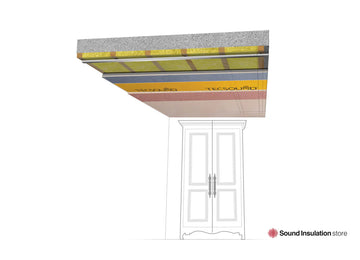
Genie 80 Ceiling System (Concrete)
The Genie 80 Ceiling System offers high level acoustic insulation in only 80mm depth from the underside of your ceiling
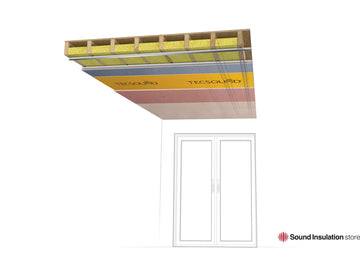
Genie 80 Ceiling System (Timber Joist)
The Genie 80 Ceiling System offers high level acoustic insulation in only 80mm depth from the underside of your ceiling
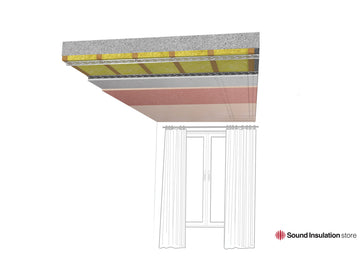
Opti 60 Acoustic Ceiling System (Concrete)
The Opti 60 Acoustic Ceiling System is our high performance ceiling system
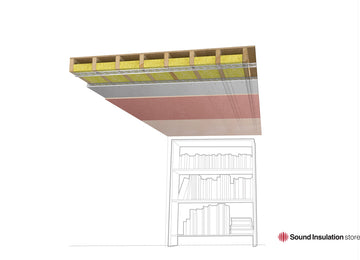
Opti 60 Acoustic Ceiling System (Timber Joist)
The Opti 60 Acoustic Ceiling System is our high performance ceiling system
How Do Acoustic Ceiling Systems Improve Soundproofing?
Part E Building Regulations specify the minimum standards for airborne sound insulation and acoustic ceiling systems play a key role in meeting these requirements.
Beyond simply meeting the required standards for new builds, our acoustics systems:
- Reduce airborne and impact noise, creating a quieter, more comfortable environment.
- Control the passage of sound between living spaces.
- Improve productivity and wellbeing in workspaces where excessive noise through dividing floors can cause distractions or challenges.
What Are the Different Types of Acoustic Ceiling Systems?
Our range includes four high-quality systems designed to meet different project requirements, spaces, and budgets.
Genie 80 Ceiling Systems (Concrete/Timber Joist)
Available for either concrete or timber joists, the Genie 80 ceiling system is designed for spaces with restricted headroom height.
Using a combination of GenieClip, Rockwool acoustic insulation, Siniat db plasterboard, Tecsound self-adhesive, and Siniat Fireline in 15mm, these systems are low-profile and provide high-performance acoustic insulation in just 80mm depth from your ceiling’s underside.
Our Genie 80 systems are suitable for domestic upgrades of existing ceilings.
Opti 60 Acoustic Ceiling Systems (Concrete/Timber Joist)
Also available for either concrete or timber joists, our Opti 60 ceiling systems provide multiple layers of acoustic mass at 60mm depth off the underside of your joists.
This system includes high-performance Maxi Resilient Bars, which can be fixed on both sides and carry a greater load, our very own dBoard product, Rockwool acoustic insulation, and the Siniat Fireline in 15mm.
The system offers a high level of acoustic reduction and relevant fire test data can be provided if required.
How Do I Know Which Acoustic Ceiling System To Choose?
Selecting the best sound insulating ceiling system from our range depends on several factors:
- Building Structure: Do you have a concrete or timber joist ceiling grid?
- Noise Type & Source: Is the noise airborne (such as voices or music) or impact (such as footsteps or machinery)?
- Intended Use: Where is the system being installed? Different spaces, like offices, schools, and residential buildings vary in acoustic insulation needs.
- Fire & Safety Regulations: Do you require a system with fire test data?
You can always speak to our team for free, expert technical advice. Simply contact us online or give us a call.
Our Experts On Acoustic Ceiling Systems
The Team At SIS Says:
“When looking at improving sound transfer between floors, an acoustic ceiling is the element that will have the most effect on improving the acoustic performance and reducing the level of sound transfer between spaces.
“The combination of insulation, isolation, and mass within your acoustic ceiling will lead to a high level of sound reduction. The correct installation detail and isolation elements are as, if not more, important than the products being installed.”
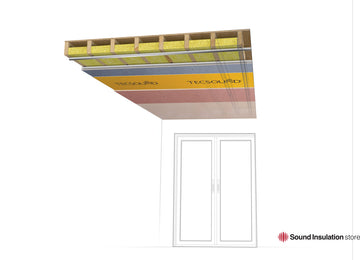
Ready to Soundproof Your Space With an Acoustic Ceiling System?
A soundproofed ceiling enhances comfort, privacy, and productivity.
Explore our acoustic ceiling systems today to find the perfect solution for your project and speak to our team for more expert information and support.
Acoustic Ceiling System
How do acoustic ceiling systems work?
Soundproof ceiling systems are specially designed to reduce sound transfer between primarily living spaces. The correct specification of isolation method, insulation type, and high-mass board will lead to a high level of sound reduction between party floors.
- Acoustic Ceiling Boards are made from high mass materials to reduce sound transfer.
- Resilient bars and Genie Clips are used to separate the ceiling structure from the main building framework, breaking the direct path for sound energy.
- Mass-loaded materials such as Tecsound membranes, acoustic plasterboard, or dB Slab insulation act as a physical barrier, blocking sound waves.
- Acoustic sealants ensure that sound does not escape through small openings, maintaining the system’s performance.
Can an acoustic ceiling system be combined with other soundproofing solutions?
Absolutely. For maximum noise protection, combine a ceiling system with other acoustic solutions such as wall systems, floor systems, and absorption panels.
How do I install my acoustic ceiling system?
Installation varies depending on the system, but most solutions include the following steps:
- Are you installing a new ceiling?
- Are you installing the ceiling retrospectively?
- Is the existing ceiling being removed?
- Fixing resilient bars or GenieClips to the existing ceiling structure.
- Adding layers of acoustic insulation, such as dBoard or Tecsound.
- Finishing off with either wet plaster or tape and joint finish.
Be sure to check out the specific system you’re installing for more details.
Where are acoustic ceiling systems most commonly used?
Our systems are commonly installed in:
- Domestic properties to prevent noise transfer between floors.
- Schools and educational spaces to control noise between classrooms.
- Residential buildings to meet Building Regulations Part E for resistance to the passage of sound.

